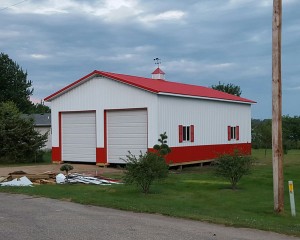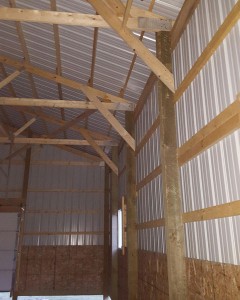Shear in the ‘Hood
The saga of the neighbor’s pole building continues….
I have restrained myself about as long as I can. Time for me to hack away at what I have to consider to be some basic design flaws. Other than the previously discussed, ‘not designed for the correct wind exposure’.
 The building is 26 feet wide by 40 feet long and 14 foot eave height. It has two 10 foot wide by 12 foot tall overhead doors in the front endwall – spaced two feet from each corner and two feet between.
The building is 26 feet wide by 40 feet long and 14 foot eave height. It has two 10 foot wide by 12 foot tall overhead doors in the front endwall – spaced two feet from each corner and two feet between.
I’ve previously written about how post frame buildings resist lateral wind forces by utilizing the strength of the skin: https://www.hansenpolebuildings.com/2011/12/lateral-wind-loads/.
Obviously large door openings are going to pose challenges in the dimensional stability of the end of our neighbor’s building. However some good structural design and the use of appropriate shear walls can take care of these issues: https://www.hansenpolebuildings.com/2012/06/shear-walls/
Assuming the unrealistic Exposure B wind speed which has been used in previous posts about this building (I am betting it’s at least wind exposure C, if not D) – each endwall needs to resist 2368.99 pounds of shear force. In the actual testing of steel panels over pole building frames to determine shear values, we came up with 160 pounds per foot when steel is properly applied to endwalls. (Interesting reading on steel shear strength testing: https://www.hansenpolebuildings.com/2012/08/this-is-a-test-steel-strength/).
Using this test proven value would require nearly 15 feet of endwall (measured across the base of the building at the end) sided with steel to carry the imposed loads!
There is a solution, which did not happen to be incorporated into this building – reinforcing the endwall of the building with structural wood panels (oriented strand board or plywood), aka “shear walls”.
So what else could be done in order to keep this building standing?
Pole buildings can be structurally designed either as “propped cantilevers” – where the diaphragms created by the roofing and siding transfer shear loads from the roof to the ground, or as cantilevers – where the posts do all of the work. The second choice results in the application of a force FOUR TIMES GREATER than when diaphragm design is used.
 Since this building does not have the ability to adequately transfer the shear loads to the ground, the cantilever design could be an option, although the columns as specified are woefully inadequate to carry loads of this magnitude.
Since this building does not have the ability to adequately transfer the shear loads to the ground, the cantilever design could be an option, although the columns as specified are woefully inadequate to carry loads of this magnitude.
Builder Leroy, in an attempt to mitigate the potential problem, installed knee braces from the columns to the trusses. I shudder to even think about the new problems which have now been created with trusses which are not designed to withstand the wind load forces now being thrown into them! More reading on the ineffectiveness of knee braces can be found at: https://www.hansenpolebuildings.com/2012/01/post-frame-construction-knee-braces/.
The structural future of this building is bleak, to say the best. In the event it blows down in our direction – we have excellent insurance coverage, and we hope our neighbor has the same.
Moral of the story – if your neighbor has a non-engineered pole building, (or an engineered one which is questionably constructed) call your insurance agent to make sure you are well covered for flying buildings (or flying building pieces) and don’t allow your policy to lapse.






